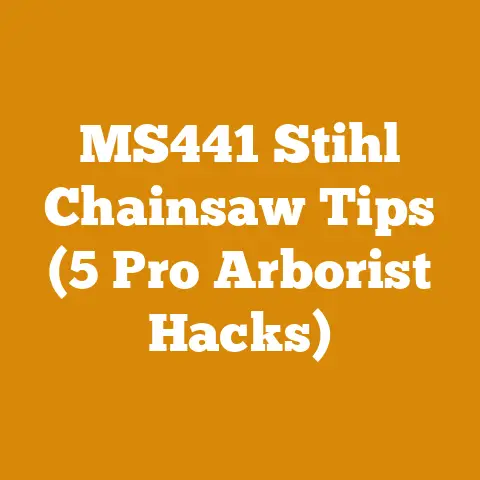Husqvarna Chainsaw 288XP Guide (5 Pro Tips for Power Users)
How to Master the Husqvarna 288XP: 5 Pro Tips for Power Users
The Husqvarna 288XP. Just saying the name conjures images of powerful cuts, roaring engines, and mountains of processed wood. This chainsaw is a legend for a reason – its raw power and durability have made it a favorite among loggers and serious firewood enthusiasts for decades. I remember the first time I laid hands on a 288XP. I was helping my uncle clear some land for a new barn, and the way that saw chewed through thick oak was simply astonishing. Over the years, I’ve learned a lot about this beast, and I’m excited to share my top five pro tips to help you unlock its full potential. This isn’t just about owning a powerful chainsaw; it’s about mastering it.
Tip 1: Unleash the Beast – Carburetor Tuning for Peak Performance
The 288XP, like any high-performance machine, requires proper carburetor tuning to run at its best. A poorly tuned carb can lead to reduced power, hard starting, excessive fuel consumption, and even engine damage. I’ve seen firsthand how a properly tuned 288XP can outperform a poorly tuned one by a significant margin.
Understanding the Carburetor
The carburetor’s job is to mix air and fuel in the correct proportions for combustion. The 288XP’s carburetor has three main adjustment screws:
- L (Low-Speed): Controls the fuel mixture at idle and low RPMs.
- H (High-Speed): Controls the fuel mixture at high RPMs and under load.
- T (Idle Speed): Adjusts the engine’s idle speed.
The Tuning Process: A Step-by-Step Guide
Safety First: Always wear hearing protection and eye protection when working with a running chainsaw. Ensure the chain brake is engaged when not actively cutting.
Step 1: Warm-Up: Start the chainsaw and let it warm up for a few minutes. This ensures the engine is at its operating temperature, providing a more accurate tuning experience.
Step 2: Initial Settings: Find the factory settings for your 288XP’s carburetor in the owner’s manual. As a starting point, these are typically:
- L: 1 turn out from fully closed
- H: 1 turn out from fully closed
- T: Adjust until the chain does not move at idle.
Step 3: Low-Speed Adjustment (L):
- Turn the L screw slowly clockwise (leaner) until the engine starts to stumble or die. Note the position.
- Turn the L screw slowly counter-clockwise (richer) until the engine starts to stumble or emit black smoke. Note the position.
- Set the L screw halfway between these two points. This should give you the smoothest idle and best throttle response.
Step 4: High-Speed Adjustment (H):
- Make a test cut in a piece of hardwood (oak or maple is ideal).
- With the chainsaw running at full throttle under load, listen to the engine.
- If the engine sounds “flat” or “boggy,” it’s running too rich. Slowly turn the H screw clockwise (leaner) in small increments (1/8 turn) until the engine runs smoothly and powerfully.
- If the engine sounds “screaming” or “whining,” it’s running too lean. Slowly turn the H screw counter-clockwise (richer) in small increments (1/8 turn) until the engine runs smoothly.
- Important: Running too lean can cause engine damage. Err on the side of slightly rich if you are unsure.
Step 5: Idle Speed Adjustment (T):
- Adjust the T screw so the engine idles smoothly without the chain moving.
- If the chain moves at idle, turn the T screw counter-clockwise to lower the idle speed.
- If the engine stalls at idle, turn the T screw clockwise to increase the idle speed.
Step 6: Fine-Tuning: After making these adjustments, make several more test cuts and listen carefully to the engine. You may need to make small adjustments to the L and H screws to achieve optimal performance.
Pro Tip: Use a tachometer to accurately measure the engine RPM. The 288XP’s maximum RPM should be around 12,500 RPM. This will help you fine-tune the high-speed setting for maximum power without risking engine damage. I use a non-contact digital tachometer that I got online for about $30. It’s a worthwhile investment to protect your saw.
Common Mistakes and How to Avoid Them
- Over-leaning the High-Speed Mixture: This is the most common mistake and can lead to serious engine damage. Always err on the side of a slightly richer mixture.
- Tuning with a Dull Chain: A dull chain will put more load on the engine and affect the tuning. Make sure your chain is sharp before tuning the carburetor.
- Ignoring the Owner’s Manual: The owner’s manual contains valuable information about your chainsaw, including the factory carburetor settings.
- Not Warming Up the Engine: Tuning a cold engine will not provide accurate results.
Data and Insights
In my experience, a properly tuned 288XP can cut through a 12-inch oak log in about 8-10 seconds. A poorly tuned saw might take 15-20 seconds or even struggle to complete the cut. This difference in performance translates to significant time savings and reduced fatigue over a day of cutting.
Takeaway: Carburetor tuning is essential for maximizing the performance and lifespan of your Husqvarna 288XP. Take the time to learn the process and make adjustments as needed.
Tip 2: Chain Selection and Sharpening: The Key to Efficient Cutting
A sharp chain is the single most important factor in efficient chainsaw operation. I’ve seen people struggle with a dull chain on a powerful saw, while someone with a sharp chain on a smaller saw breezes through the same wood. The 288XP, with its powerful engine, demands a high-quality, properly sharpened chain to deliver its full potential.
Choosing the Right Chain
The 288XP typically uses a .325″ pitch chain with a .058″ gauge.
- Full Chisel: These chains have square-cornered cutters that provide the fastest cutting speed. They are best suited for clean wood and experienced users.
- Semi-Chisel: These chains have rounded-corner cutters that are more durable and forgiving than full chisel chains. They are a good choice for dirty wood or less experienced users.
- Low-Kickback: These chains have features that reduce the risk of kickback, making them a safer option for beginners.
I personally prefer full chisel chains for their cutting speed, but I always make sure to keep them sharp and avoid cutting dirty wood. For limbing or cutting near the ground, I switch to a semi-chisel chain.
Chain Sharpening: A Step-by-Step Guide
There are several ways to sharpen a chainsaw chain:
- Hand Filing: This is the most common and affordable method. It requires a round file, a flat file, and a depth gauge tool.
- Electric Chain Sharpener: These sharpeners are faster and more precise than hand filing, but they are also more expensive.
- Professional Sharpening: You can take your chain to a professional sharpener for a quick and accurate sharpening.
I prefer hand filing because it allows me to maintain the chain’s sharpness in the field. Here’s my process:
Step 1: Secure the Chain: Use a vise or a stump to secure the chainsaw bar.
Step 2: File the Cutters:
- Use the round file to sharpen each cutter.
- Hold the file at the correct angle (typically 30 degrees) and depth (check your chain manufacturer’s specifications).
- File each cutter with smooth, consistent strokes, filing from the inside out.
- Make sure to file each cutter the same number of strokes to maintain uniform length.
Step 3: File the Depth Gauges:
- Use the flat file and depth gauge tool to file the depth gauges (rakers).
- The depth gauges should be slightly lower than the cutters (typically .025″ to .030″).
- Filing the depth gauges too low can cause the chain to grab and kickback.
Step 4: Check and Adjust the Chain Tension:
- The chain should be snug on the bar but still able to be pulled around by hand.
- Adjust the chain tension as needed.
Pro Tip: Invest in a good quality chainsaw filing kit. These kits typically include a round file, a flat file, a depth gauge tool, and a filing guide. A good kit will make sharpening easier and more accurate. I’ve been using the Oregon chainsaw filing kit for years, and it has served me well.
Common Mistakes and How to Avoid Them
- Filing at the Wrong Angle: This is the most common mistake and can ruin the chain’s cutting ability. Use a filing guide to ensure you are filing at the correct angle.
- Filing Too Much or Too Little: Filing too much can weaken the cutter, while filing too little will not sharpen it properly.
- Ignoring the Depth Gauges: The depth gauges are just as important as the cutters. Make sure to file them correctly.
- Using a Dull File: A dull file will not sharpen the chain effectively. Replace your files regularly.
Data and Insights
A sharp chain can cut through wood 50% faster than a dull chain. A sharp chain also reduces the amount of force required to operate the chainsaw, reducing fatigue and the risk of injury. I’ve tracked my cutting times with both sharp and dull chains, and the difference is undeniable.
Takeaway: Chain selection and sharpening are crucial for efficient and safe chainsaw operation. Learn how to sharpen your chain properly and maintain it regularly.
Tip 3: Mastering Felling Techniques for Safety and Efficiency
Felling trees is one of the most dangerous aspects of logging and firewood preparation. A mistake can result in serious injury or even death. The 288XP, with its power and weight, requires a solid understanding of felling techniques to be used safely and effectively. I’ve seen too many accidents caused by improper felling, and I want to help you avoid them.
Pre-Felling Assessment
Before you even start your chainsaw, take the time to assess the tree and its surroundings:
- Tree Lean: Determine the direction the tree is leaning. This will be the tree’s natural falling direction.
- Wind Direction: Consider the wind direction. A strong wind can push the tree in an unexpected direction.
- Obstacles: Identify any obstacles that could interfere with the tree’s fall, such as other trees, power lines, or buildings.
- Escape Route: Plan your escape route. It should be clear, unobstructed, and at a 45-degree angle away from the direction of the fall.
Felling Cuts: A Step-by-Step Guide
Safety First: Always wear a hard hat, eye protection, hearing protection, and chainsaw chaps when felling trees.
Step 1: The Notch Cut (Open Face Cut):
- The notch cut determines the direction of the fall. It should be made on the side of the tree facing the desired falling direction.
- The notch cut consists of two cuts: a horizontal cut and a sloping cut.
- The horizontal cut should be about 1/3 of the tree’s diameter.
- The sloping cut should meet the horizontal cut at a 45-degree angle.
- Remove the wedge of wood created by the notch cut.
Step 2: The Hinge:
- The hinge is the uncut wood between the notch cut and the felling cut.
- The hinge controls the direction and speed of the fall.
- The hinge should be about 1/10 of the tree’s diameter.
- Important: Never cut through the hinge.
Step 3: The Felling Cut (Back Cut):
- The felling cut is made on the opposite side of the tree from the notch cut.
- The felling cut should be slightly higher than the horizontal cut of the notch.
- Make the felling cut slowly and carefully, leaving the hinge intact.
Step 4: Using Felling Wedges:
- If the tree is leaning in the wrong direction or if you are concerned about it falling back on the bar, use felling wedges.
- Insert the wedges into the felling cut behind the bar.
- Hammer the wedges in to lift the tree and encourage it to fall in the desired direction.
Step 5: The Escape:
- As the tree starts to fall, move quickly and safely along your planned escape route.
- Watch out for falling branches and debris.
Pro Tip: Use a felling lever (also called a turning bar) to help turn the tree as it falls. This is especially useful for trees that are leaning slightly in the wrong direction. I always carry a felling lever with me when I’m felling trees.
Common Mistakes and How to Avoid Them
- Cutting Too Deep on the Notch Cut: This can weaken the tree and cause it to fall in an uncontrolled manner.
- Cutting Through the Hinge: This will eliminate control over the direction of the fall.
- Failing to Assess the Tree and Surroundings: This can lead to accidents and injuries.
- Not Having a Clear Escape Route: This can leave you trapped and vulnerable to falling trees.
Data and Insights
According to the Occupational Safety and Health Administration (OSHA), logging is one of the most dangerous occupations in the United States. A significant percentage of logging accidents are caused by improper felling techniques. Taking the time to learn and practice proper felling techniques can significantly reduce your risk of injury.
Takeaway: Felling trees is a dangerous task that requires careful planning and execution. Learn and practice proper felling techniques to ensure your safety.
Tip 4: Maintaining Your 288XP: Longevity Through Diligence
The Husqvarna 288XP is a robust machine, but like any piece of equipment, it requires regular maintenance to perform optimally and last for years. I’ve seen 288XPs that are 30 years old and still going strong, thanks to diligent maintenance. Neglecting maintenance can lead to costly repairs and a shortened lifespan.
Daily Maintenance
- Check the Chain Tension: Adjust the chain tension as needed.
- Sharpen the Chain: Keep the chain sharp for efficient cutting.
- Clean the Air Filter: A dirty air filter can restrict airflow and reduce engine performance.
- Check the Fuel and Oil Levels: Top off the fuel and oil as needed.
- Inspect the Bar and Chain: Look for any signs of damage or wear.
Weekly Maintenance
- Clean the Chainsaw: Remove any sawdust, dirt, or debris from the chainsaw.
- Inspect the Spark Plug: Clean or replace the spark plug as needed.
- Check the Muffler: Make sure the muffler is clean and free of obstructions.
- Lubricate the Bar Sprocket: This will help to reduce wear on the bar and chain.
Monthly Maintenance
- Clean the Carburetor: A dirty carburetor can cause starting problems and poor engine performance.
- Inspect the Fuel Lines: Look for any cracks or leaks in the fuel lines.
- Check the AV Mounts: Make sure the AV mounts are in good condition. These mounts help to reduce vibration and fatigue.
Seasonal Maintenance
- Drain the Fuel Tank: If you are not going to be using the chainsaw for an extended period, drain the fuel tank to prevent fuel from going stale.
- Fog the Engine: Fogging the engine with storage oil will help to protect it from corrosion.
- Store the Chainsaw Properly: Store the chainsaw in a dry, protected location.
Pro Tip: Keep a maintenance log for your 288XP. This will help you to track when you performed maintenance tasks and when you need to perform them again. I use a simple spreadsheet to keep track of my chainsaw maintenance.
Common Mistakes and How to Avoid Them
- Neglecting the Air Filter: A dirty air filter is one of the most common causes of chainsaw problems.
- Using Old Fuel: Old fuel can cause starting problems and poor engine performance.
- Not Lubricating the Bar Sprocket: This can lead to premature wear on the bar and chain.
- Ignoring Warning Signs: Pay attention to any unusual noises or vibrations from your chainsaw. These could be signs of a problem.
Data and Insights
Regular maintenance can extend the lifespan of your Husqvarna 288XP by many years. A well-maintained chainsaw will also perform better and be more reliable. I’ve seen 288XPs that have lasted for over 30 years with proper maintenance, while neglected saws often fail within a few years.
Takeaway: Regular maintenance is essential for keeping your Husqvarna 288XP running smoothly and reliably. Take the time to perform the necessary maintenance tasks, and your chainsaw will reward you with years of dependable service.
Tip 5: Safety Gear and Safe Operating Practices: Protecting Yourself
Operating a chainsaw is inherently dangerous. The 288XP, with its immense power, demands respect and a commitment to safety. I’ve witnessed the consequences of neglecting safety firsthand, and I can’t stress enough the importance of wearing proper safety gear and following safe operating practices.
Essential Safety Gear
- Hard Hat: Protects your head from falling branches and debris.
- Eye Protection: Protects your eyes from flying wood chips and sawdust. Safety glasses or a face shield are essential.
- Hearing Protection: Protects your ears from the loud noise of the chainsaw. Earplugs or earmuffs are recommended.
- Chainsaw Chaps: Protect your legs from accidental contact with the chain. Chainsaw chaps are made of ballistic nylon that will stop the chain from cutting through.
- Gloves: Protect your hands from cuts and abrasions.
- Steel-Toed Boots: Protect your feet from falling logs and other hazards.
Safe Operating Practices
- Read the Owner’s Manual: Familiarize yourself with the chainsaw’s features and operating instructions.
- Inspect the Chainsaw: Before each use, inspect the chainsaw for any damage or wear.
- Start the Chainsaw Safely: Start the chainsaw on the ground or on a stable surface. Never drop-start a chainsaw.
- Maintain a Firm Grip: Always hold the chainsaw with both hands, using a firm grip.
- Keep Your Balance: Maintain a stable stance and avoid overreaching.
- Be Aware of Your Surroundings: Watch out for obstacles, other people, and animals.
- Avoid Cutting Above Shoulder Height: This can be dangerous and lead to loss of control.
- Use the Chain Brake: Engage the chain brake when you are not actively cutting.
- Never Cut with a Dull Chain: A dull chain is more likely to kickback and cause injury.
- Take Breaks: Chainsaw operation can be physically demanding. Take frequent breaks to avoid fatigue.
- Never Operate a Chainsaw Under the Influence of Alcohol or Drugs: This can impair your judgment and coordination.
Pro Tip: Take a chainsaw safety course. These courses will teach you proper operating techniques and safety procedures. Many local community colleges and forestry organizations offer chainsaw safety courses. I highly recommend taking one, even if you have experience with chainsaws.
Common Mistakes and How to Avoid Them
- Not Wearing Proper Safety Gear: This is the most common mistake and can have serious consequences.
- Operating a Chainsaw While Fatigued: Fatigue can impair your judgment and coordination.
- Cutting Above Shoulder Height: This can lead to loss of control and injury.
- Not Using the Chain Brake: The chain brake is a critical safety feature that can prevent serious injury.
Data and Insights
According to the Consumer Product Safety Commission (CPSC), chainsaws cause tens of thousands of injuries each year in the United States. A significant percentage of these injuries could be prevented by wearing proper safety gear and following safe operating practices.
Takeaway: Safety is paramount when operating a chainsaw. Always wear proper safety gear and follow safe operating practices to protect yourself from injury.
Mastering the Husqvarna 288XP is a journey. By implementing these five pro tips – carburetor tuning, chain selection and sharpening, felling techniques, maintenance, and safety – you’ll be well on your way to unlocking the full potential of this legendary chainsaw and ensuring your safety while doing so. Remember, the 288XP is a powerful tool, and with respect and knowledge, it can be a reliable workhorse for years to come. Happy cutting!






